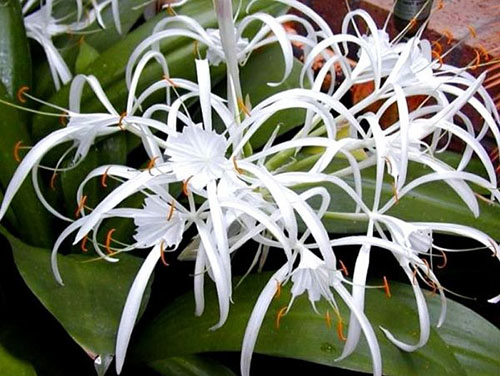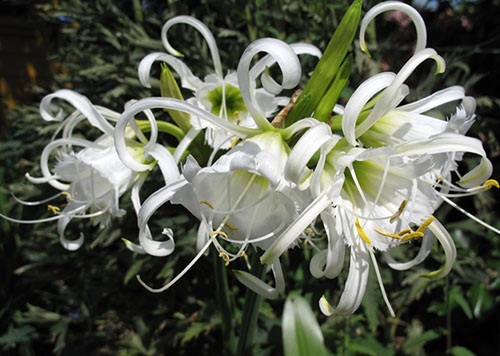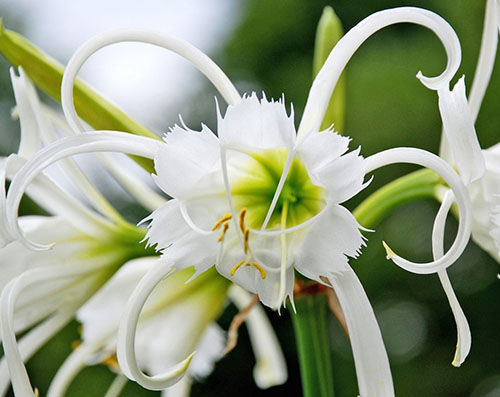Hymenocallis, or Spider Lily: A Remarkable Houseplant
Hymenocallis is a bulbous plant from the Amaryllis family, comprising over 50 species. Its native habitat is the mountainous regions of Peru and Bolivia, where the flower can be found along riverbanks. Hymenocallis is known to horticulturists as Peruvian Lily or Spider Lily, and it is cultivated as both an indoor and garden plant. However, it is recommended for outdoor planting only in regions with mild winters.
The leaves of Hymenocallis are long, strap-shaped, glossy, with a pronounced central vein and pointed tips, similar to those of the hippeastrum. The length of the leaf ranges from 40 to 70 cm, depending on the species. The bulb is large, up to 10 cm in diameter, with a pear-shaped form. Some species are evergreen, while others shed their leaves during the rest period or under unfavorable conditions.

The flower stalk grows to a height of 45 to 80 cm, with several stalks usually emerging from one bulb. The umbel-shaped inflorescences of the Spider Lily contain up to 6 large fragrant snow-white flowers. Their petals are elongated, with extended tips forming long threads, either coiled or freely hanging. In the center of the flower, there is a cup-shaped corona, resembling that of a narcissus. Perhaps that's why this flower is sometimes called the Peruvian Narcissus. After flowering, fleshy fruits with large seeds form on the flower stalks.
Types of Hymenocallis:
- Hymenocallis caribaea is often grown as an indoor plant. It lacks a clearly defined dormant period and retains its beautiful dark green leaves. Its umbel-shaped inflorescence typically bears 3-5 large white flowers, usually appearing in winter and lasting up to 4 months. Sometimes it starts blooming in late summer.
- Hymenocallis festalis has shorter dark green leaves and blooms in spring. The white flowers have a diameter of 10 cm, with gracefully curved tepals and a large, wide-open corona.
- Hymenocallis speciosa is also an evergreen variety with lanceolate-elliptic leaves up to 60 cm long. The inflorescence consists of 5-16 white flowers, approximately 15 cm in diameter.
- Hymenocallis cordifolia is distinguished by its elongated heart-shaped leaves on long stalks. The white flowers have narrow, long drooping tepals, and the corona is almost absent.
- Hymenocallis tubiflora also has stalked leaves but with a broad lanceolate shape.
- Hymenocallis caroliniana reaches a height of 45 to 90 cm. The fragrant spider-like flowers, about 17.5 cm in diameter, are arranged in clusters of up to 6. The light green leaves are shiny and long (up to 60 cm). The rest period occurs in summer.
- Hymenocallis littoralis grows to a height of 30-45 cm. The long, strap-shaped leaves can reach up to 90 cm in length. The flowering period is extended, occurring from February to May.


Tips for Caring for Spider Lily:
Light: Spider Lily thrives in sunlight. It is best placed on a well-lit window, preferably a southern one. During summer, moving the plant to a balcony can be beneficial. To encourage winter flowering, provide additional lighting with a day length of 10-12 hours.
Temperature: Warm 70-85°F/21-29°C during active growth; minimum winter temperature of 60°/16°C

Water: Regular watering is essential, as Spider Lily is a moisture-loving plant. However, avoid overwatering to prevent bulb rot. If the bulb has shed all its leaves during the rest period, refrain from watering.
Soil: Ready-made soil for bulbous plants can be purchased, or you can prepare your own mixture of river sand, leaf, and sod soil. Ideally, the soil should be slightly acidic (pH 5.0 - 6.0). Adding a bit of crushed charcoal helps prevent bulb rot.
Repotting: Choose a spacious pot for Spider Lily, as the plant develops a robust root system. A good drainage layer at the bottom is essential to prevent water stagnation. Do not bury the bulb completely; one-third should be visible above the soil. Typically, the plant is repotted every 3-4 years, as it does not favor frequent transplanting.
Fertilization: When Spider Lily produces new leaves and flowers, it needs to be fertilized. Liquid fertilizers suitable for flowering and bulbous plants can be chosen. Do not fertilize during the relative rest period.
Diseases and Pests: Spider Lily is prone to infestation by scale insects, aphids, thrips, and spider mites. If signs of disease are noticed, promptly treat the leaves with specialized solutions. The most common threat is bulb rot, so avoid excessive watering, as a rotting bulb is challenging to save. If the bulb starts to decay, carefully excavate the plant and trim the affected area, but only if the affected zone is very small.

Propagation: Hymenocallis reproduces through daughter bulbs and seeds. Bulblets appear on plants that have reached 3-4 years of age. Gently separate them from the mother bulb and plant them in individual pots.
I hope this is helpful for you!




